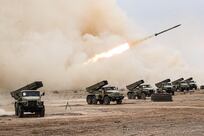CAPE TOWN // Four kilometres under the earth and it is hotter than the burning sands of Abu Dhabi’s Empty Quarter on a summers’ day.
At the West Driefontein gold mine to the west of Johannesburg, a small crew of men brave heat under a million tonnes of rock to extract a thin sliver of gold.
They use technology from decades ago; pneumatic drills hammer into the rock to prepare for blast charges. When ready, the miners hastily leave. Later a clean-up crew arrives to poke the roof with crowbars to check it is not about to cave in. If deemed safe, the rubble is removed, to be hauled to the surface above.
Producing gold steadily since the 1950s West Driefontein is the grand old lady of South African mines, but it is on the edge of its life expectancy. The trouble is not so much that gold is running out, it is that it is now so far below the surface it may as well be on the moon.
South Africa’s gold mines are in trouble as they go ever deeper in search of ore bearing rock in conditions increasingly deadly to humans. A new generation of robots and underground drones may be the breakthrough technology the industry has been waiting for.
Soon, perhaps, machines will replace the nearly half a million men who toil daily in conditions where the very walls conspire to kill them. As mines go deeper so the risk of a “rock burst” increases – an explosive fracturing of rock that will crush a man in a second.
“Eight out of 10 fall-of-ground incidents happen within 1.5 meters of the working face,” says Alex Venter, a project engineer at Sibanye Gold that operates some of the country’s oldest mines including West Driefontein. “If we can keep workers away from that space, fatalities and injuries will be virtually zero.”
Death comes in many forms underground; drowning because of flooding, being struck by moving vehicles and even fire. In 2014 eight miners died from smoke inhalation after an electrical fire broke out at Harmony Gold’s Doornkop gold mine, west of Johannesburg.
Coupled with declining fortunes and an increasingly deadly work environment the mines have sought their fracking moment – a breakthrough technology that rescues the industry, just has hydraulic fracturing revived the US energy industry. Mr Venter notes that in 1970 South Africa produced 1,000 tonnes of gold, but in 2015 managed only 189 tonnes.
“We produced more than 70 per cent of the world’s gold in our heyday; now we barely manage to produce 6 per cent.” Bullion has also declined in its contribution to the local economy. It made up 67 per cent of all mineral sales in 1980, but is now around 12,5 per cent according to the state statistics bureau StatsSA.
For much of the 20th century until 2006 South Africa was the glittering leader in gold production. It has produced 2 billion ounces of gold over the past 120 years, which is about half of all ever mined. Now it trails at 7th spot behind Peru, with China at number one. The fall from grace had been so fast and so significant that if production here collapsed entirely, it would hardly matter to global markets. “Nobody would care” Mr Venter says.
Sibanye along with its peers is now in a frantic race for survival; come up with new tech or fade into the sunset. At least two billion ounces more remain, according to Sibanye, but at depths thus far unreachable. As a result it has several robot vehicles under development; a three-tonne driller and rock breaker and a battery powered mini-dozer about the size of a large suitcase.
The latter is a kind of underground drone, remote controlled and sent into areas where the roof of the mine was barely half a metre high. In these conditions men would have to crawl, while battling 60°C heat and the constant risk of being crushed to death. The little machines will initially be sent into long abandoned sections of mines where they will sweep up rubble and dust that still contain traces of gold ore.
As it is, mineworkers at the working face, or stope, must often navigate space under 1.5 metres high – about the same amount of room under a kitchen table. This is because the vein of gold is often no more than a centimetre or two deep. Everything else is waste that has to be removed at great cost to the mine. So space saved is money saved.
A bigger machine will be used to approach a rock face and, using drills, break it up. This will be a significant departure from using explosives to reduce rock to rubble that the industry has used for more than a century.
The geology that gave South Africa its gold bounty is also its downfall. Ultra hard dolerite rock destroys steel drills and makes blasting the only way to quickly and cheaply turn it into rubble. Elsewhere in the world Canadian, American and Chinese gold mines have kinder geology to contend with and use huge bulldozers and haulers in their operations, so reducing costs.
South African mines, though, have had to keep using traditional methods, and so retains a workforce of half a million men.
“There is no easy way of breaking rock,” says the executive head of technical services at Anglo American Platinum, Gordon Smith.
“When we change the technology we use, we change how we work and that in turn alters the economics of the business.”
Like the gold miners, platinum producers are also looking for ways to remove men from the riskier parts of the operation.
Angloplat is developing a fleet of remote operated vehicles, including a fuel-cell powered mini-dozer that began life as a landmine hunting armoured vehicle in Croatia.
After more than 100 years, it seems South Africa’s mines are moving forward.
business@thenational.ae
Follow The National's Business section on Twitter





